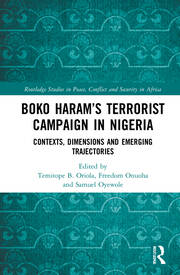Main Article Content
Boko Haram’s Terrorist Campaign in Nigeria Contexts, Dimensions and Emerging Trajectories
Abstract
Boko Haram has fast become one of the world’s most notorious terrorist groups. The longevity of Boko Haram, coupled with its dynamic nature, necessitates that scholars keep abreast with a vast and intersectional array of developments. As a result, much ink has been spilt providing analysis and insight into the group’s motives, activities, internal politics, tactics, and future trajectories. Boko Haram’s ever-green endurance both in Nigeria and the wider West African region paves the way for a scholarly momentum which Oriola, Onuoha and Oyewole’s edited collection aligns with. The book has 12 chapters which are split across five thematic areas, namely: gender, the media, displacement, non-state actors, human rights, and non-state actors. It is beyond the scope of this review to place each chapter under the microscope. Instead, the reviewer will highlight some of the most important contributions the book makes to the academic discourse on Boko Haram. Chapter three (by Oyewole and Onuoha) provides the reader with a comprehensive account of the Dapachi Kidnapping of 2018; this contribution is significant as much scholarship as focused on the Chibok Kidnappings of 2014. Oyewole and Onuoha unpack why the Dapachi Kidnappings took place, placing an emphasis on the need for Boko Haram to portray itself as a resilient origination so as to appear appealing to prospective members, to raise funds (by means of hostage negotiations), and rewarding hardworking foot solders with ‘wives’ and sex slaves. Furthermore, context is given to Dapachi’s geographical and political vulnerability vis-à-vis Boko Haram’s terrorist campaign.



